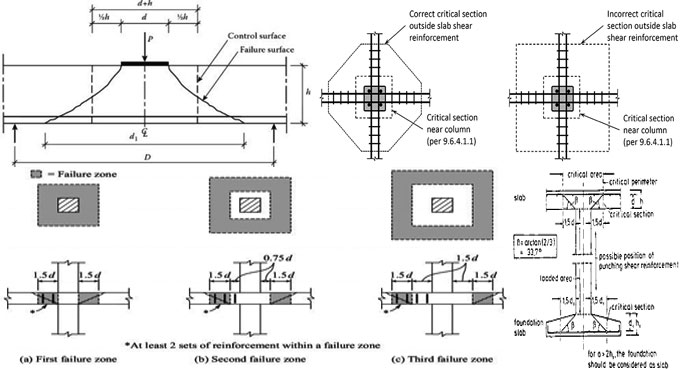Definition of Punching Shear?
The punching shear refers to a failure system that occurs in structural members like slabs and foundation with presence of shear under the action of concentrated loads.
The punching shear refers to a failure system that occurs in structural members like slabs and foundation with presence of shear under the action of concentrated loads.
The action of concentrated loads remains on a minor area in the
structural members. Normally, this reaction is the one from the column that
behaves against the slab.
The
punching shear failure mechanism can be applied in normal floor slabs, flat
slabs, and in the foundation slabs underneath the column.
Punching
Shear in Reinforced Concrete Slabs: The Punching shear in reinforced concrete
slabs is treated as a 2D analog of the shear detected in beams. Due to
unforeseen crack, this type of failure happens. It becomes difficult to control
this crack by making use of main reinforcement.
Therefore, the ultimate load capacity of the structure is
decreased underneath the flexural capacity with the action of shear. The
punching shear is not so important with regards to beam shear.
In
slabs, the punching shear happens if there are high values of concentrated
loads for slabs. These load ranges from the wheel loads on the bridge slabs or
the loads from over floors on the columns that support the slab floors.
Calculations in Punching Shear: If it is required to compute
punching shear for the design, it is dependent on the punching shear force that
is punching against the density of the slab or foundation. It can occur only if
shear remains separately in the system. It becomes impossible, if any form of
moment is in the pedestal or the column.
The
Maximum Punching Shear Stress is obtained on the basis of the punching shear
failure cone and the applied values of shear and moments. The ‘d’ denotes the
effective depth of the slab. The punching shear perimeter is developed at a
gapping of d/2 from the edges of the column or the pedestal. In the example
given in fig 1, Dped stands for the depth of the pedestal.
1. Proper
examinations should be done to ensure that the concrete is very durable.
2. If there is not sufficient strength for the concrete, verify whether the amount of supplied reinforcement is proper.
3. If it is improper, it will be better to adjust the form of the structure.
2. If there is not sufficient strength for the concrete, verify whether the amount of supplied reinforcement is proper.
3. If it is improper, it will be better to adjust the form of the structure.
The
form of the structure can be adjusted in the following ways:
1. Raise
the depth of the slab
2. Expand the column size
3. Assimilation of drop panels
4. Creation of Flared column heads
5. Other foreign codes are recommended to practice other liberal designs
2. Expand the column size
3. Assimilation of drop panels
4. Creation of Flared column heads
5. Other foreign codes are recommended to practice other liberal designs
Different
failure zones are described in the example given in figure-2 that is based
together with the area where the reinforcement should be arranged. Normally
vertical and traverse failure lines can be provided. It becomes difficult to
identify where the failure can take place. Therefore, each prospective failure
plane should have been reinforced.

No comments:
Post a Comment